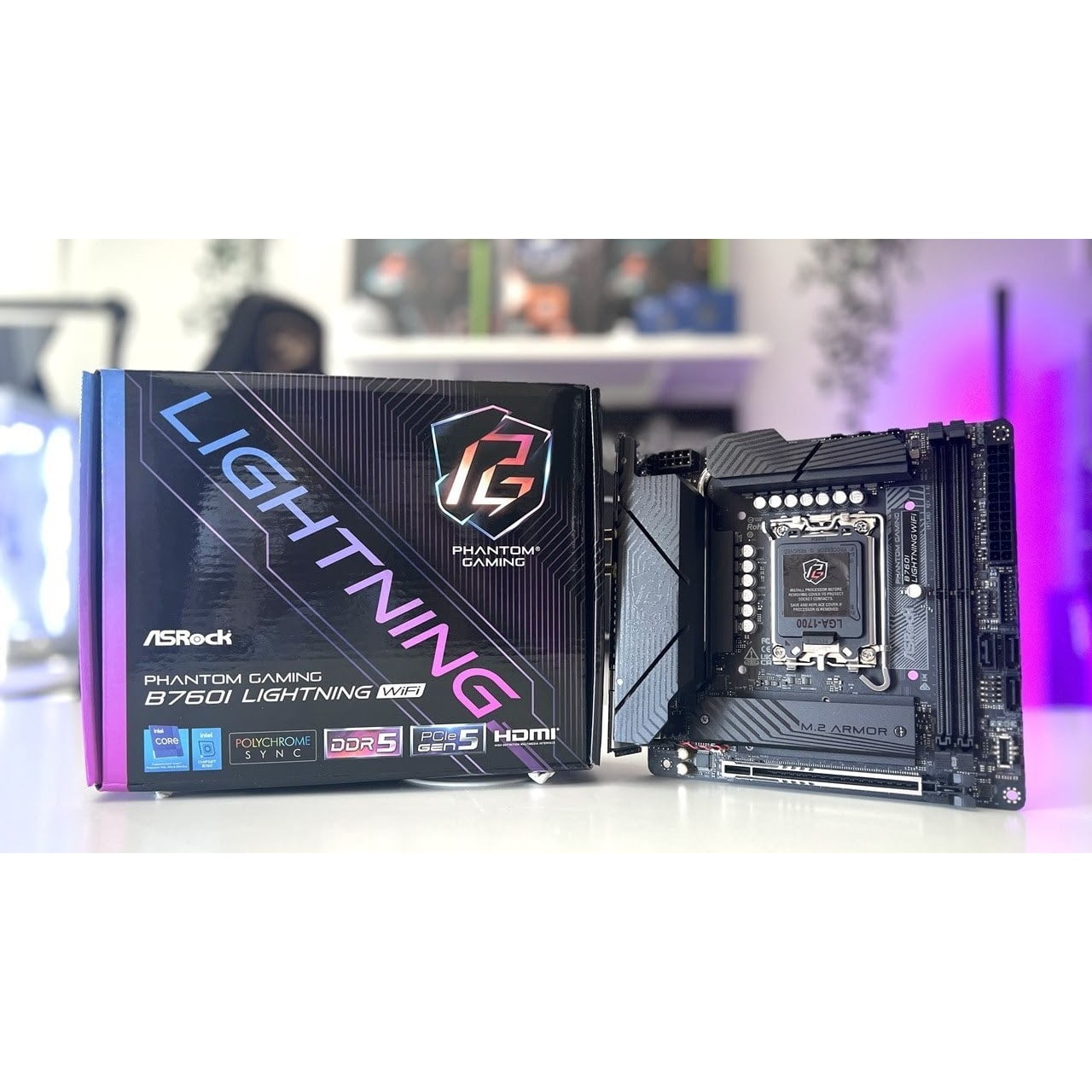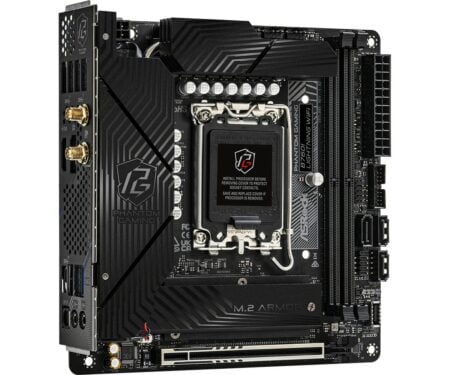CONS
- Only five USB Type-A ports
ASROCK B760I LIGHTNING WI-FI SPECS
| Form Factor |
Mini-ITX |
| CPU Socket |
Intel LGA 1700 |
| Chipset |
Intel B760 |
The ASRock B760I Lightning Wi-Fi is a cost-effective option at on Newegg. This Mini-ITX motherboard, utilizing Intel’s B760 chipset, offers impressive features such as memory overclocking up to DDR5-8600+ (OC), native 14th Generation CPU support, robust power delivery, two M.2 sockets, three SATA ports, budget-friendly audio, and built-in Wi-Fi. While it lacks rear USB ports with only five Type-A ports, the ASRock B760I Lightning Wi-Fi is a comprehensive choice for Mini-ITX builders who do not intend to overclock their CPUs.
Board Design, CPU, and Memory.
Mini-ITX motherboards have limited space for elaborate design features compared to larger form factors. The Lightning model opts for a sleek black look with an 8-layer PCB, slots, and heatsinks. The VRM heatsinks are connected by a heatpipe to efficiently dissipate heat produced by the power delivery components, with a small fan discreetly placed between the rear I/O and the heatsink. The fan is only audible under heavy workloads. ASRock has incorporated linear and angular elements on top of the heatsinks to symbolize lightning, resulting in an all-black board without built-in RGB lighting (although it does offer headers for customization) that complements various build aesthetics.
The B760I Lightning Wi-Fi is compatible with Intel’s 12th, 13th, and 14th Generation processors. In terms of hardware, it features a 16-phase power design that utilizes 110A SPS MOSFETs, with 14 of them dedicated to Vcore. With a total of 1540A available, it provides more than enough power even for high-end processors like our Core i9-14900K. The VRM heatsinks, which are actively cooled, effectively prevent the power components from overheating. While you cannot overclock the CPU like you can on boards with BCLK generators, you can still push the limits when it comes to memory overclocking.
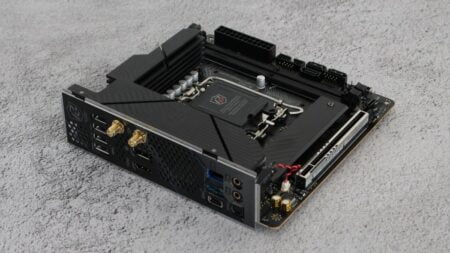
The B760 and Z790 platforms offer impressive RAM support, with the maximum listed up to DDR5-8600+ (OC). This is among the highest you’ll find in the market. One advantage of smaller boards, like the Mini-ITX, is that they tend to have more headroom for memory overclocking. This is due to their smaller traces and lower capacity, typically having two DRAM slots instead of four. ASRock goes a step further by supporting the new 48GB sticks or kits, allowing for a memory ceiling of 96GB. For most users, this should be more than sufficient. However, if you require even more memory capacity, Mini-ITX motherboards are not the right choice as they are limited to two memory slots.
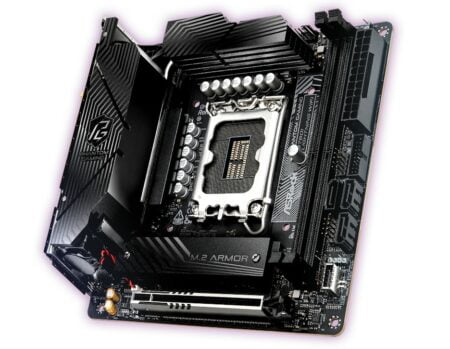
ASRock’s BIOS offers a wide range of settings to adjust the RAM, such as voltage, primary, secondary, and tertiary timings. We found that all three kits we tested (DDR5-5600, DDR5-7200, and DDR5-8000) remained stable once the internal profile was configured, with the Lightning model being one of the few that could support our DDR5-8000 kit without additional voltage adjustments. It is important to note that achieving these high speeds (especially above DDR5-7200) will likely require a processor with a robust integrated memory controller and a memory kit that is QVL-certified.
Design and Internal Ports.
Commencing our circuit board tour from the top left corner, we observe a solitary EPS connector exclusively designed to supply power to the CPU. The substantial VRM heatsink, connected by a heatpipe, possesses ample mass and surface area to effectively perform its function, aided by the inconspicuous miniature fan positioned beneath it. Positioned above the uppermost VRM heatsink are multiple headers, encompassing a 3-pin ARGB for personalizing your own lighting and three 4-pin fan headers. The management of any connected RGB strips is seamlessly executed through ASRock’s Polychrome RGB application.
The chassis-fan headers can provide a maximum output of 1 amp/12 watts, whereas the CPU_FAN1/WP can support up to 2A/24W. Sufficient headers and power are available to operate multiple system fans or an AIO cooler.
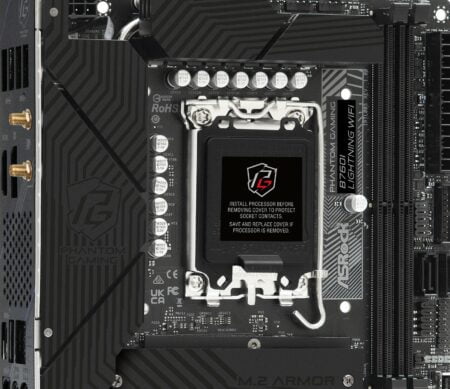
To the right, we can observe the pair of unfortified DRAM slots equipped with locking mechanisms on either side. Once again, this motherboard proudly offers exceptional compatibility with the B760 or Z790 platform, enabling seamless integration with high-speed RAM modules. Therefore, if you have a memory controller in your processor that can keep up with lightning-fast speeds, the Lightning motherboard is more than capable of accommodating it.
On the right side, we come across the remaining 3-pin ARGB header, accompanied by the 24-pin ATX connector that supplies power to the motherboard below it. I am eagerly anticipating the arrival of motherboards equipped with the new ATX12VO connector, which occupies less space. Directly below that, there are two USB headers—a 19-pin header for USB 3.2 Gen 1 (5Gbps) and an additional header for USB 2.0 ports. Following those, we find three SATA ports mounted vertically. If you wish to configure a RAID array, ASRock provides RAID modes 0, 1, and 5. Lastly, there are the front-panel headers used to connect the power/reset button and the front USB 3.2 Gen 1 (5Gbps) Type-C port.
The Realtek ALC897 audio codec, the front-panel audio header, and a few audio capacitors are situated at the left corner of the board’s bottom edge. Although the ALC897 may not be the most exceptional audio solution, it adequately serves the budget segment of the market it caters to. Positioned in the center of the board are the sole full-length PCI Express slot and the primary M.2 socket.
Growth, Retention, and Back Panel Connectivity.
The discussion regarding the PCI Express expansion slots on Mini-ITX boards can be brief, as there is only a single slot available. This reinforced slot is capable of running at PCIe 5.0 x16 speeds. Regardless of how you populate the storage, you will receive the full bandwidth since it does not support bifurcation or lane sharing like motherboards with extra storage and slots.
The initial M.2 slot is located beneath the heatsink, just above the PCIe slot. This slot is equipped with its own plate-style heatsink and operates at PCIe 4.0 x4 (64Gbps) speed, connecting through the CPU. It can accommodate devices up to 80mm in length. The second M.2 slot, positioned at the rear of the board, obtains its PCIe 4.0 x4 bandwidth from the chipset and also supports modules up to 80mm in size. Completing the storage options are the three vertically mounted SATA ports.
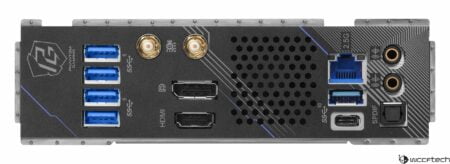
Our compact board is equipped with a preinstalled backplate at the rear I/O, showcasing sleek “lightning” lines against a black background. It also features strategically placed holes or perforations to facilitate the flow of cool air to the small fan housed inside. The rear section is relatively simple, offering a total of six USB ports. Among them, there are two USB 3.2 Gen 2 (10Gbps) ports, one Type-A and one Type-C, along with four USB 3.2 Gen 1 (5Gbps) Type-A ports.
When utilizing the integrated graphics of select processors, you will be able to link up to the HDMI 2.1 or DisplayPort 1.4 ports. For network connectivity, there is a Realtek 2.5GbE port and Intel Wi-Fi 6E antenna connections available. In addition, the audio setup includes two 3.5mm analog jacks (mic-in and line-out) as well as an optical S/PDIF output.
An Overview of the UEFI BIOS and Tools.
The BIOS found in the B760I Lightning Wi-Fi resembles those of motherboards in ASRock’s Phantom Gaming series. In both the Easy and Advanced modes, the user-friendly PG Gaming theme is utilized, featuring red and white text against a dark backdrop. Easy mode provides details on the processor, RAM, storage, fans, and other components, while also allowing for the activation of XMP profiles and customization of thermal throttling limits.
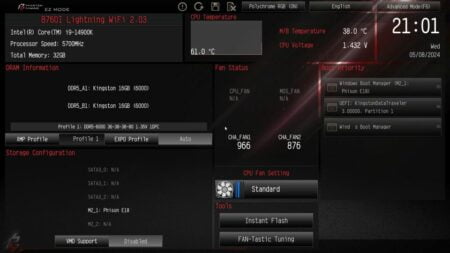
The BIOS’s Advanced mode section provides a conventional setup with primary categories displayed at the top, such as Main, OC Tweaker, Advanced, Tool, H/W Monitor, and Boot. The Main page primarily serves as an informative section, particularly from the My Favorites segment. It is possible to create a personalized BIOS page that includes a list of your frequently accessed items.
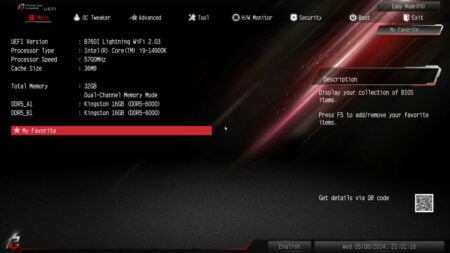
The OC Tweaker section provides the necessary tools for customizing your system. Within this section, you have the ability to modify voltages, RAM settings, and the CPU configuration, as well as store profiles for future use.
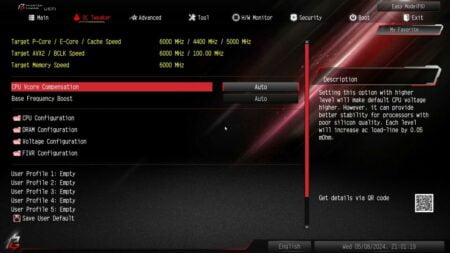
The Advanced section provides access to CPU, chipset, storage, NVMe, ACPI, and USB configuration settings, as well as options for Intel Thunderbolt and Trusted Computing support. Additionally, users can customize the UEFI’s interface and choose whether it boots in Easy Mode or directly to a specific page within the Advanced settings.
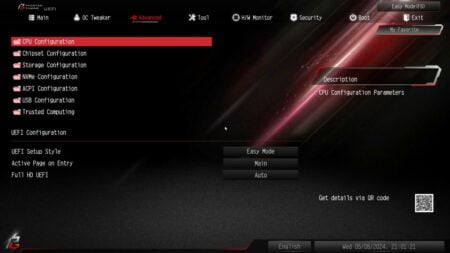
The Tools section, which is not shown in the picture, provides access to ASRock Polychrome RGB for controlling lighting, as well as tools for SSD and NVMe sanitation or secure-erase. It also includes the Instant Flash utility for flashing your BIOS. The H/W Monitor displays important system information such as CPU and motherboard temperatures, fan speeds, and voltages. In this section, you can adjust the fan speeds of all the onboard 4-pin fan headers.
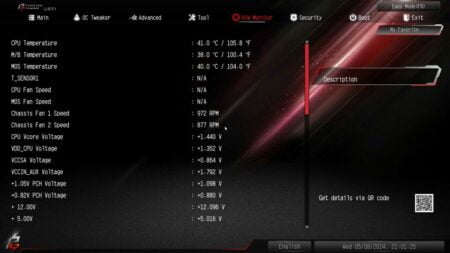
ASRock’s BIOS offers a comprehensive range of features and a user-friendly interface, comparable to its competitors. It allows control over RGB lighting, fans, and even includes a storage sanitization option. In general, it offers a multitude of practical functionalities, and our limited testing confirmed the stability of the latest version (2.05).
Regarding software, ASRock’s Appshop provides the option to download and update drivers, while the A-Tuning program allows for system customization. The Appshop proves to be beneficial as it enables the download of utilities like Polychrome RGB LED, Nahimic 3 audio, and the App Charger. Additionally, it performs driver checks and facilitates direct updates, serving as an excellent alternative for users who are not accustomed to obtaining the latest drivers directly from vendor websites.
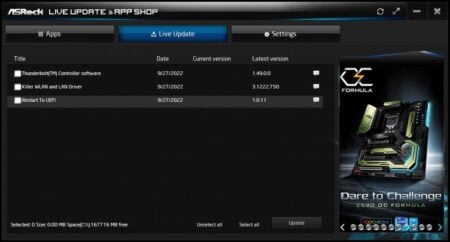
A-Tuning is a comprehensive tweaking application designed for users who enjoy customizing their systems. With this tool, you can easily adjust fan speeds, monitor detailed system information such as temperatures, voltage, clock speeds, and ratios, as well as fine-tune the CPU.
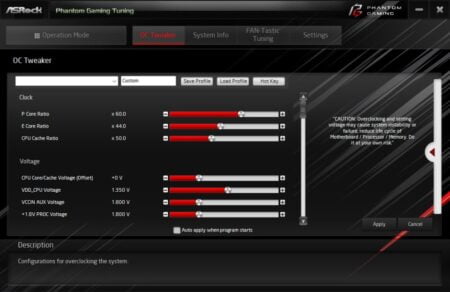
Judgment: Appealing Price and Performance, Limited USB Ports.
The ASRock B760I Lightning Wi-Fi motherboard caters to a specific segment within the Mini-ITX market. Priced at less than it offers a PCIe 5.0 slot, two PCIe 4.0 M.2 sockets, three SATA ports, high-speed 2.5GbE and Wi-Fi 6E connectivity, compatibility with the newest Intel processors and fast RAM, as well as robust power distribution.
If you require a M.2 socket that is compatible with PCIe 5.0, it is recommended to consider a Z790 board instead. This is because none of the currently available B760 platforms support the latest high-end SSDs. It is important to note that the B760 chipset is designed for budget builds. One of the main drawbacks of the Lightning motherboard is the limited number of USB ports on the rear I/O, with only six available (five Type-A). Additionally, the VRMs on this platform are considered to be overkill. While this feature is impressive, it is worth mentioning that the platform cannot overclock the CPU like its more powerful counterpart, the Z790I Lightning, which holds the record for breaking records. ASRock could have potentially saved some costs on the bill of materials while still maintaining a capable power delivery system.
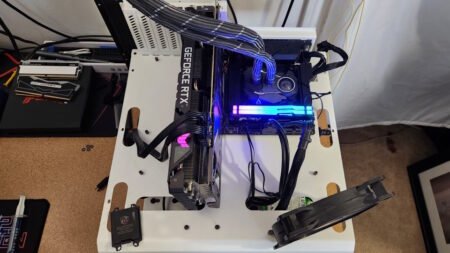
In the same market segment, there are usual alternatives available. The Asus ROG Strix B760-I Gaming Wi-Fi is another option that supports DDR5. On the other hand, the Gigabyte B760I Aorus Pro DDR4 provides a 20Gbps USB-C port but only has one M.2 socket. We have also evaluated the MSI B760I Edge, which is a commendable but slightly pricier option at. However, none of these options clearly outshines the others, making the ASRock a reliable purchase if you are content with five USB-A ports and do not intend to overclock your processor. Just ensure that you appropriately configure the cooling settings in the BIOS, as this will enhance power limits and performance beyond the default “auto” setting.

